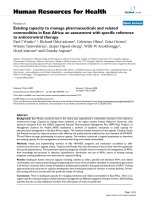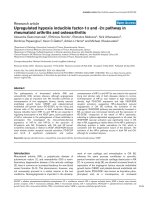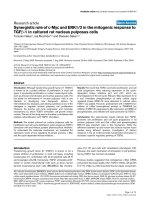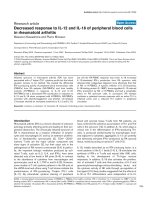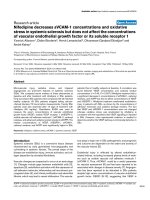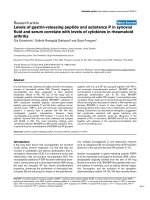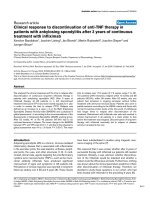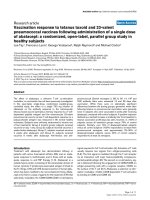Báo cáo y học: "An intervention to improve paediatric and newborn care in Kenyan district hospitals: Understanding the context" ppsx
Bạn đang xem bản rút gọn của tài liệu. Xem và tải ngay bản đầy đủ của tài liệu tại đây (312.9 KB, 8 trang )
BioMed Central
Page 1 of 8
(page number not for citation purposes)
Implementation Science
Open Access
Research article
An intervention to improve paediatric and newborn care in Kenyan
district hospitals: Understanding the context
Mike English*
1,2
, Stephen Ntoburi
1
, John Wagai
1
, Patrick Mbindyo
1
,
Newton Opiyo
1
, Philip Ayieko
1
, Charles Opondo
1
, Santau Migiro
3
,
Annah Wamae
3
and Grace Irimu
1,4
Address:
1
KEMRI Centre for Geographic Medicine Research – Coast, & Wellcome Trust Research Programme, P.O. Box 43640, Nairobi, Kenya,
2
Department of Paediatrics, University of Oxford, Oxford, UK,
3
Division of Child Health, Ministry of Public Health and Sanitation, Nairobi, Kenya
and
4
Department of Paediatrics, College of Health Sciences, University of Nairobi, Nairobi, Kenya
Email: Mike English* - ; Stephen Ntoburi - ;
John Wagai - ; Patrick Mbindyo - ;
Newton Opiyo - ; Philip Ayieko - ;
Charles Opondo - ; Santau Migiro - ;
Annah Wamae - ; Grace Irimu -
* Corresponding author
Abstract
Background: It is increasingly appreciated that the interpretation of health systems research studies is greatly facilitated by
detailed descriptions of study context and the process of intervention. We have undertaken an 18-month hospital-based
intervention study in Kenya aiming to improve care for admitted children and newborn infants. Here we describe the baseline
characteristics of the eight hospitals as environments receiving the intervention, as well as the general and local health system
context and its evolution over the 18 months.
Methods: Hospital characteristics were assessed using previously developed tools assessing the broad structure, process, and
outcome of health service provision for children and newborns. Major health system or policy developments over the period
of the intervention at a national level were documented prospectively by monitoring government policy announcements, the
media, and through informal contacts with policy makers. At the hospital level, a structured, open questionnaire was used in
face-to-face meetings with senior hospital staff every six months to identify major local developments that might influence
implementation. These data provide an essential background for those seeking to understand the generalisability of reports
describing the intervention's effects, and whether the intervention plausibly resulted in these effects.
Results: Hospitals had only modest capacity, in terms of infrastructure, equipment, supplies, and human resources available to
provide high-quality care at baseline. For example, hospitals were lacking between 30 to 56% of items considered necessary for
the provision of care to the seriously ill child or newborn. An increase in spending on hospital renovations, attempts to introduce
performance contracts for health workers, and post-election violence were recorded as examples of national level factors that
might influence implementation success generally. Examples of factors that might influence success locally included frequent and
sometimes numerous staff changes, movements of senior departmental or administrative staff, and the presence of local 'donor'
partners with alternative priorities.
Conclusion: The effectiveness of interventions delivered at hospital level over periods realistically required to achieve change
may be influenced by a wide variety of factors at national and local levels. We have demonstrated how dynamic such contexts
are, and therefore the need to consider context when interpreting an intervention's effectiveness.
Published: 23 July 2009
Implementation Science 2009, 4:42 doi:10.1186/1748-5908-4-42
Received: 16 January 2009
Accepted: 23 July 2009
This article is available from: />© 2009 English et al; licensee BioMed Central Ltd.
This is an Open Access article distributed under the terms of the Creative Commons Attribution License ( />),
which permits unrestricted use, distribution, and reproduction in any medium, provided the original work is properly cited.
Implementation Science 2009, 4:42 />Page 2 of 8
(page number not for citation purposes)
Introduction
The poor quality of care offered to children in hospital in
many low-income settings [1,2], including Kenya [3,4],
has been widely reported. The challenge is now therefore
to define interventions that might improve this care. We
have previously described the design of a randomized,
parallel group intervention study that aims to investigate
whether a package of interventions delivered to Kenyan
government district hospitals can improve paediatric and
newborn care [5]. Similarly, we have described the devel-
opment and content of a major part of the intervention
package: evidence-based clinical practice guideline book-
lets (CPGs), a standard paediatric admission record form
(PAR) [6] and a five-day training course focusing on emer-
gency and admission care and use of the CPGs (Emer-
gency Triage Assessment and Treatment plus Admission
Care, ETAT+) [7]. Additional aspects of the intended inter-
vention package included: external support supervision,
local facilitation, performance assessment, and feedback.
However, training and guidelines may only result in
changes in the provision of care in settings with adequate
physical and human resources. Supervision and feedback
may have little effect if staff and management are preoccu-
pied with other priorities, while a specific intervention
effect might be hidden by any broad, major health sector
developments. At a local level, the intervention delivered
may work to different degrees in hospitals of different
sizes or those that lose key personnel or trained staff.
Here, therefore, we describe the hospitals and the health
system as contexts within which this multi-faceted inter-
vention was delivered. Understanding the dynamic nature
of this context and its potential for influencing the effect
of the intervention is an important precursor to under-
standing or generalizing any results [8,9]. This report also
provides the backdrop to additional specific and prospec-
tively specified studies examining health worker motiva-
tion [10], the barriers that might prevent health workers
following guidelines [11], and the perspectives of
the research team and the recipient health workers on the
adequacy of delivery of the intervention [12] (see
Appendix 1).
Methods
The Kenyan health sector
Kenya is a low-income country with a population of 33
million and a GDP per capita of $580 in 2006 USD http/
ddp-ext.worldbank.org/ext/ddpreports/ViewShare
dReport?&CF=&REPORT_ID=9147&REQUEST_TYPE=VI
EWADVANCED. In 2004 and 2005, government spend-
ing on health was $9.1 per capita representing 7.7% of
total government spending
. The
level of government spending on health has been increas-
ing in absolute terms since 2001, although remaining rel-
atively stable as a proportion of total government
spending
while general eco-
nomic growth improved from 0.4% to more than 6% over
the period from 2000 to 2006
.
Although the country made important health gains in the
decades leading up to 1990, this was followed by a period
of stagnation and then deterioration, at least for child sur-
vival, with mortality of children less than 5 years old
increasing from 97 per 1000 in 1990 to 121 per 1000 in
2003 />. Among
many factors that will have contributed to these worsen-
ing health indicators, economic decline, a public sector
employment freeze, and, until recently, minimal invest-
ment in health services despite continued population
growth and an emerging human immunodeficiency virus
(HIV) epidemic are perhaps the most important.
Organisationally, publicly provided health services are
based around the district administrative level. Districts in
turn are responsible to provincial (regional) and then
national offices. Each district is normally served by one
designated district hospital. The district hospitals are run
by a hospital management team, usually comprised of a
senior clinician, a senior nurse, a pharmacist, an adminis-
trator, and other heads of department. This team is
responsible to a local hospital management board. The
district hospital often provides primary and inpatient care
services to a surrounding urban and nearby rural catch-
ment area and, in principle, also provides referral care and
inpatient services in support of a network of rural primary
care facilities spanning the district. At the time of study
design Kenya had 70 districts. These were subsequently
divided to yield a total of 140 districts in 2007, mid-way
through the intervention study, although for practical pur-
poses this did not impact on the study. It is not possible
to summarise adequately the entire scope of the health
policy context, however, in principle government provid-
ers were expected to supply free health care services for
children less than five years of age.
Hospital selection and data collection
In total, there are thought to be over 300 hospitals provid-
ing general inpatient services in Kenya [13]. Of these, just
over 120 are operated by the government, while faith-
based or not-for-profit organizations support a similar
number. The rationale for selection of the eight study hos-
pitals and their 'recruitment' has been explained else-
where [5], while their location is indicated in Figure 1. It
is clearly hard to claim that only eight facilities are a true,
nationally representative sample. We therefore aimed to
document and describe key health system attributes,
related to care of the severely ill newborn or child, that
would allow others to consider how representative this
sample is of the wider Kenyan or regional hospital sector
Surveys were conducted by three teams of four or five
health workers specifically trained for the task and led by
Implementation Science 2009, 4:42 />Page 3 of 8
(page number not for citation purposes)
at least one full-time member of the research team. Data
were collected using multiple tools, adapted from previ-
ous work [4], that aimed to describe hospital care within
the classical Donabedian framework of structure, process,
and outcome [14]. Relevant tools are briefly described in
Table 1. Although the specific structure attributes would
be linked to those of process and both to specific out-
comes in the classical health production model, this pre-
cise linear thinking is rarely possible when attempting a
hospital-wide quality of care assessment such as the one
described. Instead, broad panels of indicators have been
assessed that help define quality of structure, quality of
process, and quality of outcomes as discrete although
linked phenomena.
While data on structure (facility inventory) and from care-
taker responses represent point-in-time, actual observa-
tion that collected from medical records and from
structured interviews is retrospective in nature and poten-
tially more subject to bias. While it is unlikely that major
events affecting hospitals would be misreported during
interviews, the quality of information for less major
events, such as the details of staff rotation, may be
affected. Data collected from medical records suffers from
the problem that it is assumed what is not recorded is not
done. For patient assessment tasks this is particularly the
case, and such process indicators reflect both quality of
documentation and practice. However, the assessment
indicators selected are fundamental to appropriate care
for sick children with common conditions (for example,
the child's weight) and were part of existing standards of
practice in the form of disease-specific government prac-
tice guidelines. Further process indicators, based on cor-
rectness of drug or fluid prescription for example, are less
subject to such biases. Using these tools, the descriptions
presented of the structure, process, and outcome charac-
Map of Kenya showing location of intervention (H1 to 4) and control (H5 to 8) hospitalsFigure 1
Map of Kenya showing location of intervention (H1 to 4) and control (H5 to 8) hospitals.
Implementation Science 2009, 4:42 />Page 4 of 8
(page number not for citation purposes)
teristics of the hospitals as contexts are based on compre-
hensive surveys conducted for two weeks at each site
between 9 July and 19 August 2006 prior to any interven-
tion (Survey 1). We planned to repeat surveys in all sites
at approximately five to six months (Survey 2), 11–12
months (Survey 3), and 17–18 months (Survey 4) after
randomly allocating hospitals to two groups of four
(referred to as intervention and control hospitals, see
below and [5]) and after initiation of the intervention.
Data on national and local policy and management
changes collected during these follow-up surveys are pre-
sented, but data describing structure, process, and out-
comes of care will be presented elsewhere.
For surveys, initial training was conducted for all staff over
two weeks and was based around a 'Survey Workers Hand-
book' that described the study, approaches to data collec-
tion, and the specific rules for recording data related to
every question for each tool. Practical training included:
thorough familiarization with the study purpose; relevant
communication skills including obtaining informed con-
sent; discussion of bias and the importance of objectivity
among survey staff; question by question discussion of
each survey tool to develop a common understanding and
agreed rules for data recording; role play or classroom
practice for data collection with each tool and three days
of practical experience in data collection at the National
Hospital. Group discussion was used to resolve remaining
uncertainties over data recording with all final decisions
recorded in an updated and final version of the 'Survey
Workers Handbook' carried by each survey member.
Documenting change in the hospitals as contexts
At the outset of this programme, we established a basic
approach to record, prospectively, major health system
events beyond the scope of our intervention, relevant to
child and newborn health, that might influence health
sector performance. This involved monitoring the passage
of any parliamentary bills, directives from the Minister of
Health or Finance or key senior civil servants in these min-
istries, and monitoring the countries two major newspa-
pers. In addition, data were collected using structured
interviews with hospital staff (see Table 1) and cross-
checked during contact with facilitators. Relevant findings
from these activities, organized with respect to the con-
duct of hospital surveys, are presented together with a
brief overview of the Kenyan health sector collated from
published data or reports.
Experience and results
Study hospitals
Key characteristics of the study hospitals at baseline
are illustrated in Additional File 1 and their location in
Figure 1.
Structure and service organisation
Study hospitals had generators and for the main part were
able to maintain electricity supplies but in four hospitals
(three intervention, one control) considerable problems
with water supply were present. Acute, walk-in care for
sick children under five years of age is generally provided
as part of maternal and child health clinics during the
working week, and by general outpatient or casualty
departments at nights and weekends. In five hospitals
(three intervention, two control) clinical officer interns,
and in two hospitals medical officer interns (one interven-
tion, one control), were part of the clinical workforce pro-
viding admission paediatric care. Both cadres of intern
rotate for three months through the paediatric depart-
ment, and although they considerably increase the total
Table 1: Simple description of tools used and purpose of each tool
Data collection Tool Focus of data collection
Facility inventory checklists. Data based on the
observation of the survey team leader and, where
necessary, the response of senior administrators or
department heads.
To record availability of water/electricity.
To document staff numbers and department allocations.
To record the presence/absence of key items of equipment, essential drugs, essential
consumables, and availability of laboratory tests. For equipment or laboratory tests,
the item had to be functional as well as present.
To record aspects of the organization of services – for example whether or not triage
was operational in clinic areas providing walk-in services for sick newborns and
children.
Medical record data abstraction tool To record what was documented for newborns and children about the admission
clinical assessment, diagnosis, and treatment, key aspects of inpatient care and
outcome. Aim: 400 randomly selected case records per site from the six months prior
to the survey.
Caretaker interview (used after gaining informed consent) Structured interview questionnaire including specific data collected at patient discharge
on caretaker's knowledge of the patient's diagnosis and post-discharge treatment. Aim:
50 consecutive, prospectively identified admissions during the survey period.
Major events/changes structured interview For post-baseline surveys a short structured interview with senior hospital staff was
performed to identify major new initiatives affecting the hospital or major staff
movements.
Implementation Science 2009, 4:42 />Page 5 of 8
(page number not for citation purposes)
number of clinical service providers the result is a rapidly
changing clinical workforce. Nursing numbers are low,
with one nurse for each 12 to 18 paediatric beds even dur-
ing the day. At night in smaller hospitals (hospitals H1,
H4 and H5) there was often only one nurse on duty on the
paediatric ward, and even during the day it was rare for a
nurse to be specifically assigned to the newborn nursery.
Hospitals were relatively poorly equipped to deal with a seri-
ously ill child. Based on a set of priority items for providing
care that might have to be used to manage a paediatric (three
areas) or neonatal emergency (one area), hospitals were lack-
ing between 27% and 55% of items. Maternal and child
health clinics and outpatient/casualty departments were
most deficient. The proportion of drugs named in the CPGs
as essential to admission or early care (n = 29) missing from
either of the paediatric ward or the pharmacy varied from
41% to 62% although, importantly, all of these drugs were
available in at least one of these locations at the time of the
survey in all eight hospitals.
Process of care
Medical records documenting the admission event for
infants and children aged 7 days to 59 months were writ-
ten as short, non-standardised, free-text notes at all eight
sites. Retrieval of archived records was possible in seven
sites, but in one control site (H5) large numbers of patient
records were missing. This was attributed to a lack of sta-
tionery and therefore use of a patient-held outpatient
book (retained by the caretaker on discharge) even for
inpatient documentation. In records, examined age was
generally well-documented for inpatient children, but
weight was recorded in fewer than 50% of admissions in
seven of eight hospitals, while temperature and vaccina-
tion status were documented in fewer than 10% of admit-
ted children in six of eight sites. Documentation of
specific clinical signs important for the diagnosis and
severity classification of common illnesses was very poor
(Additional File 1) with the exception of pallor and, occa-
sionally, cyanosis. Across all eight sites, even in the face of
poor documentation, 347 children had recorded clinical
signs indicating a probable need for lumbar puncture (LP)
according to CPG criteria. Only nine LPs were docu-
mented as performed. In terms of management, quinine
loading doses were prescribed to fewer than 10% of
admitted malaria cases for whom the drug was used in
seven of eight sites. Only 9 of 238 (2.5%) children admit-
ted for intravenous fluid therapy for severe dehydration
had a fluid prescription indicating the correct volume of
fluid and duration of administration. In 122 cases of chil-
dren admitted with severe malnutrition, a prescribed feed-
ing plan was available for only nine (7%).
Outcomes
Among study hospitals the number of paediatric admis-
sions varied from just under 1,000 to nearly 5,000 per
year with inpatient paediatric mortality varying from
5.2% to 13.7%. Outcome indicators reflecting caretakers'
knowledge about their child's illness and management at
discharge showed that more than 50% of caretakers knew
their child's diagnosis in six of eight sites. However, in
only two hospitals were 50% or more of caretakers aware
of the frequency with which they had to administer dis-
charge drugs.
Context
In Additional File 2 we outline changes in the health sec-
tor originating at the national level that might influence
hospital or health worker performance in all eight hospi-
tals. Across the eight hospitals, income generated from
cost recovery (user fees) and available to the hospital
management team to spend, varied considerably from
approximately $10,000 per month to approximately
$45,000 per month (Additional File 3). This variation
reflects both variability in hospital size and the ability of
the catchment population to pay. Although, in theory,
services for children are free, in practice all hospitals levy
a bed charge on the caretaker staying with the child and
payment is often required for specific treatments or inves-
tigations. In three hospitals (H1, H3 and H5), there were
major changes (>50% increase) in bed-day charges over
the 18 months of the intervention. Although all govern-
ment hospitals, each site had at least one additional part-
ner, varying from non-governmental organizations to
bilateral aid programs, providing direct local support
(Additional File 3). In seven of eight sites, partners were
helping support provision of HIV services. None of the
hospitals were receiving broad support from partners for
provision of newborn or child health services, although in
one hospital at baseline (H6) and a second during the
intervention (H1) ready-to-use nutritional products for
severe malnutrition were provided. During the 18 months
of the study, both the government and local partners pro-
vided inputs that may have helped improve hospital care
for newborns and children. These inputs varied and
included, for example: funds for maintenance and renova-
tion of facilities; improved drug and consumable supplies
from the Kenyan Medical Supplies Agency (KEMSA); pro-
vision of oxygen concentrators and newborn incubators;
and construction of boreholes to improve water supplies
(Additional File 3).
At least as significantly, regular changes in senior staff
were observed at all sites. Examples include two changes
within 18 months of the medical superintendent (hospi-
tals H5 and H6), four changes within 18 months of senior
nursing personnel in paediatric areas (H3), and major
internal rotations (≥ 20 staff) with exchange of nurses
familiar with the intervention for those with none (H1,
H2 and H3). Although there were new postings of medical
and nursing staff, these just kept pace with transfers and
resignations to maintain total staffing numbers reasona-
Implementation Science 2009, 4:42 />Page 6 of 8
(page number not for citation purposes)
bly constant, although for some smaller hospitals (H4)
numbers of general medical officers varied considerably
and meant for prolonged periods none was allocated to
the paediatric wards. The variability in clinical medical
staffing was particularly pronounced in the two largest
hospitals (H3 and H7) that received medical officer
interns where the intervention of 18 months spanned six
scheduled changeovers in medical personnel in these
sites.
Discussion
The study design aimed to balance intervention and con-
trol group hospitals on the basis of size, presence of a pae-
diatrician and medical officer interns, and some basic
characteristics of the geographic location [5] (Additional
File 1, Figure 1). It can be seen this also resulted in reason-
able balance with respect to many gross structural
attributes of hospital care, including organizational
aspects of care, availability of human resources, equip-
ment, and drugs at baseline. Intervention group hospitals,
however, tended to have higher inpatient paediatric mor-
tality. For indicators related to the process of hospital care,
intervention group hospitals and control group hospitals
fared equally badly in general at baseline. These baseline
data also indicate that little progress had been made in
improving paediatric care, or in implementing available
WHO and national treatment recommendations in the
four years between the baseline surveys reported and sim-
ilar surveys in 2002 involving seven of these hospitals
[3,4].
Although the baseline cross-sectional data provide some
reassurance that the process of randomization helped
achieve group balance, the highly dynamic reality of hos-
pitals evidenced by the prospectively organized approach
to description underscores the need for caution when
interpreting the results of the intervention in the future.
The data presented are, we hope, an aide to those inter-
ested to consider for themselves the plausibility of any
cause and effect relationship attributed to the interven-
tion. National level developments, such as improved
health spending or introduction of new management
approaches, both of which occurred during the interven-
tion period, would be expected to affect all hospitals in a
similar way and no specific regional initiatives were
encountered. However, we cannot discount the possibility
that national directives are differentially applied and/or
significantly affected by a hospital's local administration
and management, potentially affecting uptake of new
hospital and health worker practices. More obviously, it is
clear that hospitals work with a range of partners and ini-
tiatives at a local level. None during our observations tar-
geted improvements in child and newborn health care
broadly other than the planned intervention. However,
some may have influenced the quality of service provision
for specific aspects of care, such as the provision of incu-
bators for the newborn, effects that might be attributed to
our broad intervention unless documented. Alternatively,
the intervention's effectiveness might be negatively
affected by prioritization of other areas, and in this regard
it is interesting to note that seven of eight hospitals were
working with non-governmental partners supporting
HIV-related activities often bringing considerable
resources.
Such rich contextual data have a number of implications.
Firstly, the diversity encompassed by the simple term 'hos-
pital', even in a sample of only eight in one low-income
setting, is striking. This is rarely considered in national or
international debate, or in interpretation of results of
research or evaluation. Secondly, hospital management
and staffing are clearly likely to be poorly described by a
single round of data collection. In the light of our study, it
should also be clear, despite some reassurance provided
by randomization, that there is considerable scope for
residual confounding and bias to influence the direction
of results, both of which may be time-varying in direction
or magnitude. Such careful descriptions of the type we
have attempted may allow the plausibility of any causal
relationship between intervention and response to be
scrutinized and debated, but do not overcome these
potential problems of bias and hidden confounding.
While very large randomized controlled trials might be
expected to provide a solution, it is questionable whether
they are feasible and even if performed it would appear
prudent that they still be accompanied by detailed
description.
Perhaps the most striking finding resulting from our
attempts to track changes in hospital contexts is the rapid-
ity of turnover in senior hospital management, senior
departmental nursing staff, and clinical service providers
relevant to delivery of paediatric and newborn services.
Such turnover was apparent in all hospitals and resulted
from staff transfers between hospitals, locally controlled
internal staff rotation of nurses, scheduled rotation of
clinical staff linked to training requirements and, where
clinical staff were few, reallocation of clinical staff away
from paediatric and newborn areas that were considered a
low priority. Thus any intervention aimed at changing
service provision must transcend these staff dynamics to
be successful in changing practice over the long term. A
factor that encouraged us to explore the role of a local
facilitator as part of the intervention, alternatively, or in
addition, hospitals or implementers interested in achiev-
ing long-term change may need to develop strategies for
expert staff retention. While this might encompass incen-
tives to retain staff in rural or underserved areas, thought
should also be given to revising routine staff rotation pol-
icies.
Implementation Science 2009, 4:42 />Page 7 of 8
(page number not for citation purposes)
Conclusion
We have presented a detailed description of a set of Ken-
yan government rural hospitals included in an interven-
tion study examining an approach to improving
paediatric and newborn care. We have attempted to char-
acterize important aspects of the national setting, the hos-
pitals, and the major changes at national and local levels
that might affect the results of an intervention delivered
over an 18-month period. Such data are thought to be
essential to understanding and generalizing the results of
public health efficacy or health systems intervention stud-
ies of this kind where interpretation is based largely on the
plausibility of linking interventions to outcomes [9]. It is
clear that hospitals as contexts are highly dynamic.
Among the national level changes we documented,
including the post-election violence in Kenya, we did not
identify any that might obviously influence the perform-
ance of any one or any subset of hospitals. At the local
level, major changes in all hospitals in senior personnel
and clinical and nursing staff would seem the most likely
general threat to the long-term success of any interven-
tion. It is also possible that key local personnel changes or
the actions of local partners could have a major influence
on the success of interventions aiming to change the pro-
vision of services, reinforcing the case for as detailed a
description as possible of the context and process of inter-
vention when interpreting the outcomes of health system
interventions. The tools we have developed and used pro-
vide one way to capture appropriate data. Such tools
could be further adapted for health system-wide assess-
ments examining the quality of hospital care at a national
level. These data could inform key policy developments
and help target resource delivery in line with service pro-
vision and equity goals.
Competing interests
The authors declare that they have no competing interests.
Authors' contributions
The idea for the study was conceived by ME who obtained
the funding for this project. Preparation for and conduct
of the study was undertaken by all authors. ME produced
the draft manuscript to which all authors contributed dur-
ing its development. All authors approved the final ver-
sion of the report.
Appendix 1
Summary of linked research studies intended to facilitate
interpretation and appraisal of the final results of a multi-
faceted, hospital care improvement intervention in Ken-
yan rural, government hospitals.
Study 1: An intervention to improve paediatric and new-
born care in Kenyan district hospitals: Understanding the
context – Intended to describe relevant health policy and insti-
tutional environment and changes over the 18 months inter-
vention and study hospitals in terms of human and material
resource capacity and indicate nature (quality) of care provided
for children and newborns at baseline.
Study 2 Contextual influences on health worker motiva-
tion in district hospitals in Kenya – Intended to explore
health worker motivation in study hospitals prior to any inter-
vention as motivation is considered to be a potentially impor-
tant modifier of implementation success.
Study 3: Documenting the experiences of health workers
expected to implement guidelines during an intervention
study in Kenyan hospitals – Intended to describe from the
health workers' perspective factors that may prevent broad use
of the guidelines with data collection undertaken 4–5 months
after initiating the intervention.
Study 4: Implementation experience during an eighteen
month intervention to improve paediatric and newborn
care in Kenyan district hospitals – Intended to describe how
the intervention was actually delivered over the 18 months and
explore health workers views of different intervention
approaches after 16–18 months of intervention.
These studies are aimed at allowing others to consider: i)
How this Kenyan setting might be representative of their
own setting, facilitating an assessment of generalisabilty,
ii) How well the intervention was delivered, its 'ade-
quacy', and, iii) The range and complexity of factors that
might influence success or failure of the intervention as
they assess the plausibility of links between intervention
and reported results.
Additional material
Additional file 1
Table S2. Basic workload statistics, structural, process and outcome
indicators relevant to paediatric and newborn care in all hospitals at
baseline (hospitals H1 – H4 later received the full intervention, H5 –
H8 acted as contemporaneous controls). The data provided provides a
description of the hospitals at baseline and the findings of the baseline
quality of care surveys.
Click here for file
[ />5908-4-42-S1.doc]
Additional file 2
Table S3. National level contextual factors potentially influencing
effectiveness of the hospital based intervention programme to improve
quality of paediatric and newborn care. The data provided indicate how
the national health policy context changed during the progress of the
study.
Click here for file
[ />5908-4-42-S2.doc]
Publish with BioMed Central and every
scientist can read your work free of charge
"BioMed Central will be the most significant development for
disseminating the results of biomedical research in our lifetime."
Sir Paul Nurse, Cancer Research UK
Your research papers will be:
available free of charge to the entire biomedical community
peer reviewed and published immediately upon acceptance
cited in PubMed and archived on PubMed Central
yours — you keep the copyright
Submit your manuscript here:
/>BioMedcentral
Implementation Science 2009, 4:42 />Page 8 of 8
(page number not for citation purposes)
Acknowledgements
The authors are grateful to the staff of all the hospitals included in the study
and colleagues from the Ministry of Public Health and Sanitation, the Minis-
try of Medical Services and the KEMRI/Wellcome Trust Programme for
their assistance in the conduct of this study. This work is published with the
permission of the Director of KEMRI.
Funds from a Wellcome Trust Senior Fellowship awarded to Dr. Mike Eng-
lish (#076827) made this work possible. The funders had no role in the
design, conduct, analyses, or writing of this study nor in the decision to sub-
mit for publication.
References
1. Nolan T, Angos P, Cunha A, Muhe L, Qazi S, Simoes EA, Tamburlini
G, Weber M, NF Pierce: Quality of hospital care for seriously ill
children in less-developed countries. The Lancet 2000,
357:106-110.
2. Reyburn H, Mwakasungula E, Chonya S, Mtei F, Bygbjerg I, Poulsen A,
Olomi R: Clincial assessment and treatment in paediatric
wards in the north-east of the United Republic of Tanzania.
Bulletin WHO 2008, 86:132-139.
3. English M, Esamai E, Wasunna A, Were F, Ogutu B, Wamae A, Snow
RW, Peshu N: Delivery of paediatric care at the first-referral
level in Kenya. The Lancet 2004, 364:1622-1629.
4. English M, Esamai E, Wasunna A, Were F, Ogutu B, Wamae A, Snow
RW, Peshu N: Assessment of inpatient paediatric care in first
referral level hospitals in 13 districts in Kenya. The Lancet
2004, 363:1948-1953.
5. English M, Irimu G, Wamae A, Were F, Wasunna A, Fegan G, Peshu
N: Health systems research in a low-income country: easier
said than done. Archives of Diseases in Childhood 2008, 93:540-544.
6. Mwakyusa S, Wamae A, Wasunna A, Were F, Esamai F, Ogutu B,
Muriithi A, Peshu N, English M: Implementation of a structured
paediatric admission record for district hospitals in Kenya –
results of a pilot study. BMC international health and human rights
2006, 6:9.
7. Irimu G, Wamae A, Wasunna A, Were F, Ntoburi S, Opiyo N, Ayieko
P, Peshu N, English M: Developing and introducing evidence
based clincial practice guidelines for serious illness in Kenya.
Archives of Diseases in Childhood 2008, 93:799-804.
8. Huicho L, Da'Vila M, Campos M, Drasbek C, Bryce J, Victora C: Scal-
ing up intergrated management of childhood illness to the
national level: achievements and challenges in Peru. Health
Policy and Planning 2005, 20(1):14-24.
9. Victora C, Habicth J, Bryce J: Evidence-based public health: mov-
ing beyond randomized trials. American Journal of Public Health
2004, 94(3):400-405.
10. Mbindyo P, Gilson L, Blaauw D, English M: Contextual influences
on health worker motivation in district hospitals in Kenya.
Implementation Science 2009, 4:
43.
11. Nzinga J, Mbindyo P, Mbaabu L, Warira A, English M: Documenting
the experiences of health workers expected to implement
guidelines during an intervention study in Kenyan hospitals.
Implementation Science 2009, 4:44.
12. Nzinga J, Ntoburi S, Wagai J, Mbindyo P, Mbaabu L, Migiro S, Wamae
A, Irimu G, English M: Implementation experience during an
eighteen month intervention to improve and newborn care
in Kenyan district hospitals. Implementation Science 2009, 4:45.
13. Noor A, Gikandi P, Hay S, Muga R, Snow R: Creating spatially
defined databases for equitable health service planning in
low-income countries: the example of Kenya. Acta Tropica
2004, 91:239-251.
14. Donabedian A: The quality of medical care. Science 1978,
200:856-864.
Additional file 3
Table S4. Hospital level contextual factors potentially influencing
effectiveness of the hospital based intervention programme to improve
quality of paediatric and newborn care. The data provided indicate how
the local health policy and organizational context changed during the
progress of the study.
Click here for file
[ />5908-4-42-S3.doc]

